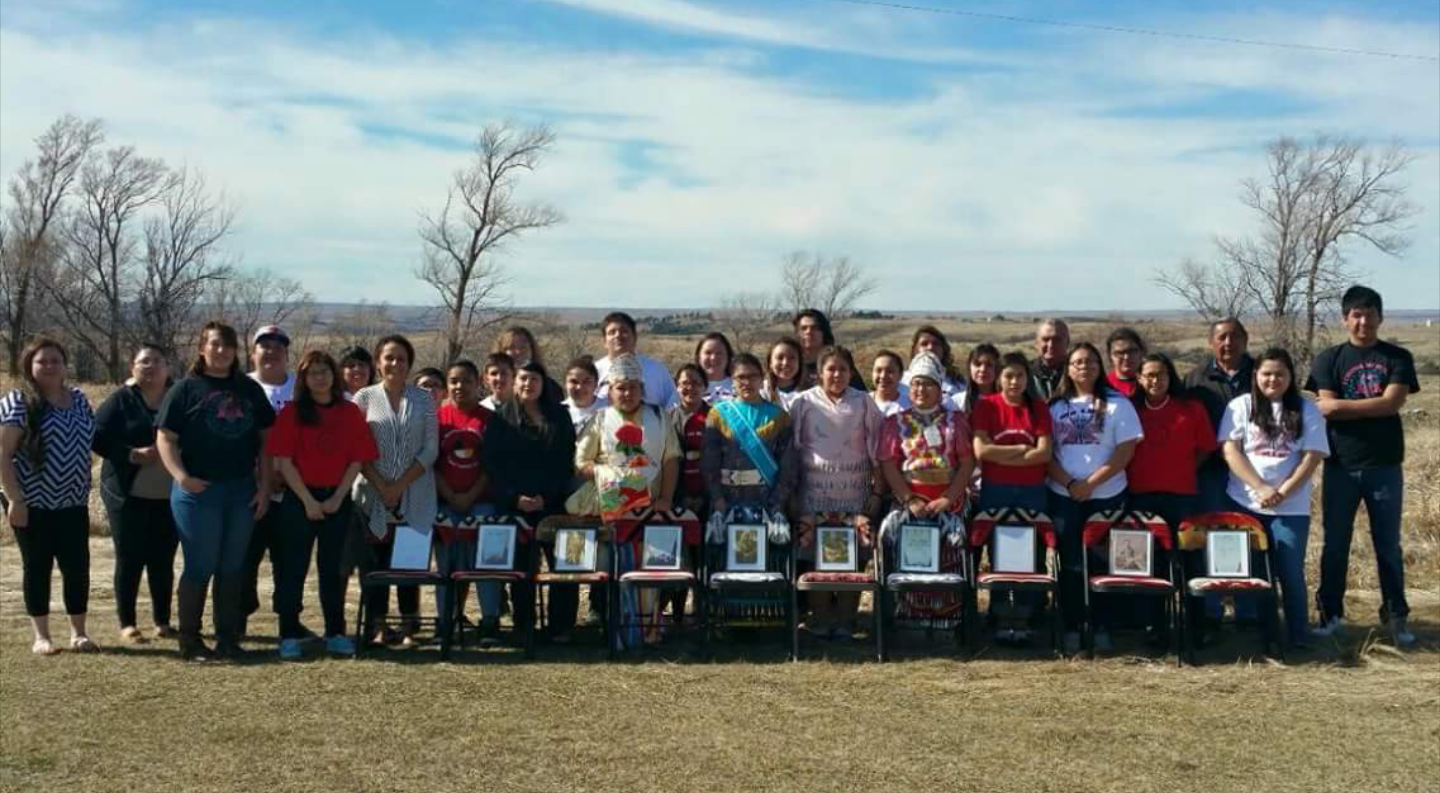THE POWER OF THE SPIRIT: LAKOTA YOUTH WORK TO BRING BACK THE CHILDREN
by Marla Fogelman |
Last July, at a cemetery on the site of the former Carlisle Indian Industrial School in Carlisle, Pa., 29 Lakota youths from the Rosebud Tribe in South Dakota, gathered around the graves of their 10 tribal brothers and sisters who had been buried there in the 1880s. After performing a prayer ceremony, the youths placed a piece of candy atop each grave marker, in keeping with Lakota custom, to offer nourishment to the spirits of the children.
“It was a very emotional experience,” said Defending Childhood Rosebud Coordinator Vikki Eagle Bear, describing the youths’ reactions to seeing the graves of the young Lakota and other Native American children who had died at this culture-suppressing boarding school during the 1880s. “I don’t think there was a dry eye.”

The 10 chairs in front represent the Sicangu (Rosebud Sioux) children still buried at Carlisle, Pa. also pictured are Youth Council members, Defending Childhood staff, Tokala Inajinyo Suicide Prevention staff, the Tribal Historic Preservation Office director, and the Rosebud Sioux Tribe’s treasurer. (Photo courtesy of RST DCI Sicangu Youth Council Facebook Page.)
According to Eagle Bear, the group of 12- to 18-year-olds, who are all members of the Defending Childhood Sicangu Youth Council, had been learning about historical trauma1 before stopping at Carlisle as part of a trip to Washington, D.C. But it was not until they walked onto the cemetery grounds that they were able to express their feelings openly. “There was a sense of both anger and sadness,” reflected Eagle Bear.
And no wonder. The Lakota children who had died at Carlisle had been forcibly removed from their homes and families as part of a larger national re-acculturation effort, or what Dr. Maria Yellow Horse Brave Heart categorized as the “boarding school period” phase of the historical unresolved grief of Native Americans, during which Native American children and families were displaced and destroyed.2
The Carlisle Indian Industrial School, the first federally funded boarding school in the United States, was founded in 1879 by Capt. Richard Henry Pratt, a former Union officer who believed it was his own personal and religious calling to “civilize” Native Americans.
Pratt, who subscribed to the notion that it was necessary to “kill the Indian… to save the man,” ran his school with a combination of righteous and military zeal. He forbade his students from speaking in their native languages, even in private conversations. He also made them cut their hair, wear military-style uniforms, and choose new “Anglo” names.3
Although the Defending Childhood Sicangu Youth Council members had learned about the school and what had happened to these students before arriving at Carlisle, Eagle Bear said it was not until after the youths had stood there, paying their respects to the Carlisle students, that they also felt moved to act.
As one youth asked at the end of the visit, “Our spirits get to come back with us; why can’t theirs?”
Soon afterward, with the blessing of their tribal leaders, the Youth Council members began an effort to repatriate the remains of the Lakota children buried at Carlisle, partnering with the Rosebud Tribal Historic Preservation Office, the Rosebud Sioux Tribal Council, and the Tokala Inajinyo Suicide Prevention Program youth group.
Facing an Obstacle and Taking Action
Unfortunately, they immediately faced a significant roadblock. Because the cemetery is situated on the grounds of an active U.S. Army base, the terms of the Native American Graves Protection and Repatriation Act4 do not apply. The group learned they would have to request permission from the commanding officer of the U.S. Army War College in Carlisle—and they did, but were refused.
So they petitioned the government, just as Captain Pratt had done to establish his “Indian” school, almost a century and a half ago. After contacting the Carlisle commanding officer, they sent letters to South Dakota legislators asking for assistance—and then to President Obama for his possible intercession.
The Spirit of the Children
Although the outcome of the repatriation effort is currently unclear, what is clear is that the Youth Council members have transformed their anger and sorrow into spirit-healing action and empowerment. They continue to give presentations and interviews on their repatriation project.
And they have made progress. After gaining support from various lawmakers, the repatriation request was forwarded to staff at Arlington National Cemetery, and the Army has now expressed an interest in meeting with the Rosebud Lakota and other tribes to discuss the legal details through a government-to-government consultation.5
Although the historical trauma that the tribe has experienced won’t be wholly resolved with the return of the children’s remains, “it’s a first step,” offered Eagle Bear.
And, because of the efforts of the Lakota Youth Council, it’s a step that may help the tribe resolve some of its intergenerational grief.
“We believe in the power of the spirit,” said Eagle Bear. “And the spirit of the children is still there.”
References
1Substance Abuse and Mental Health Services Administration (SAMHSA). 2016. “Types of Trauma and Violence.” Rockville, Md.: SAMHSA, U.S. Department of Health and Human Services. http://www.samhsa.gov/trauma-violence/types
2Daw, Raymond, and Maria Yellow Horse Brave Heart. 2011. “Welcome to Takini’s Historical Trauma.” Albuquerque, N.M.: No Fun Zone Consulting.
3Earenfight, Phillip, Molly Fraust, Stephanie Latini, Kathleen McWeeney, Kathryn M. Moyer, Laura Turner, and Antonia Valdes–Dapena. 2004. “Richard Henry Pratt: 1840–1924.” In Visualizing a Mission: Artifacts and Imagery of the Carlisle Indian School, 1879–1918. Carlisle, Pa.: Trout Gallery, Dickinson College.
4National Park Service. 2016. “National NAGPRA” (Native American Graves Protection and Repatriation Act). Washington, D.C. http://www.nps.gov/nagpra
5Gammage, Jeff. 2016. “Those Kids Never Got to Go Home.” Philadelphia, Pa.: Philadelphia Media Network.
|
|
|
